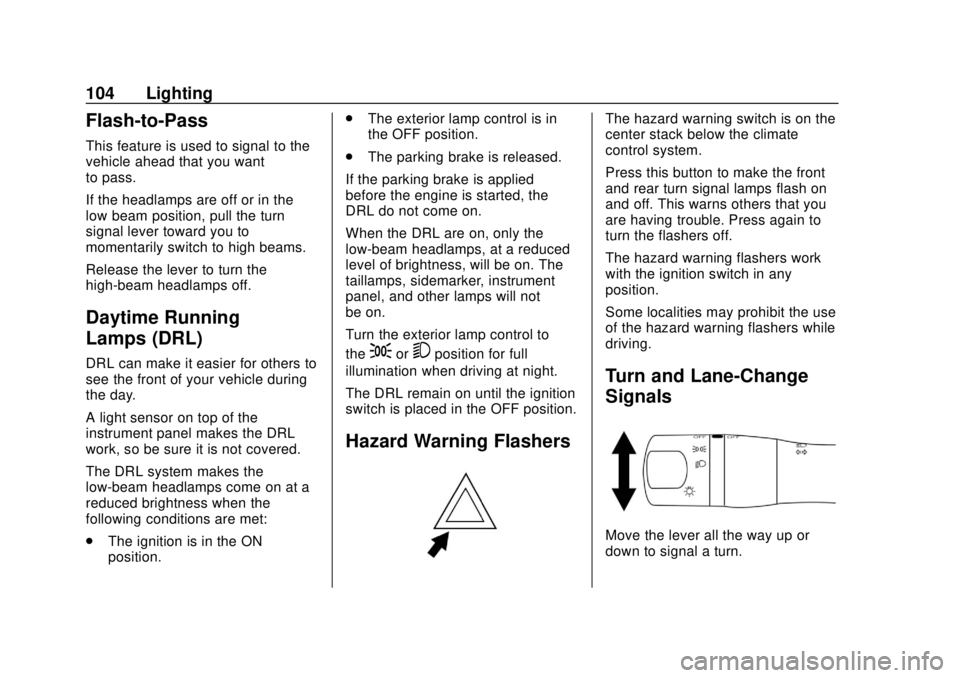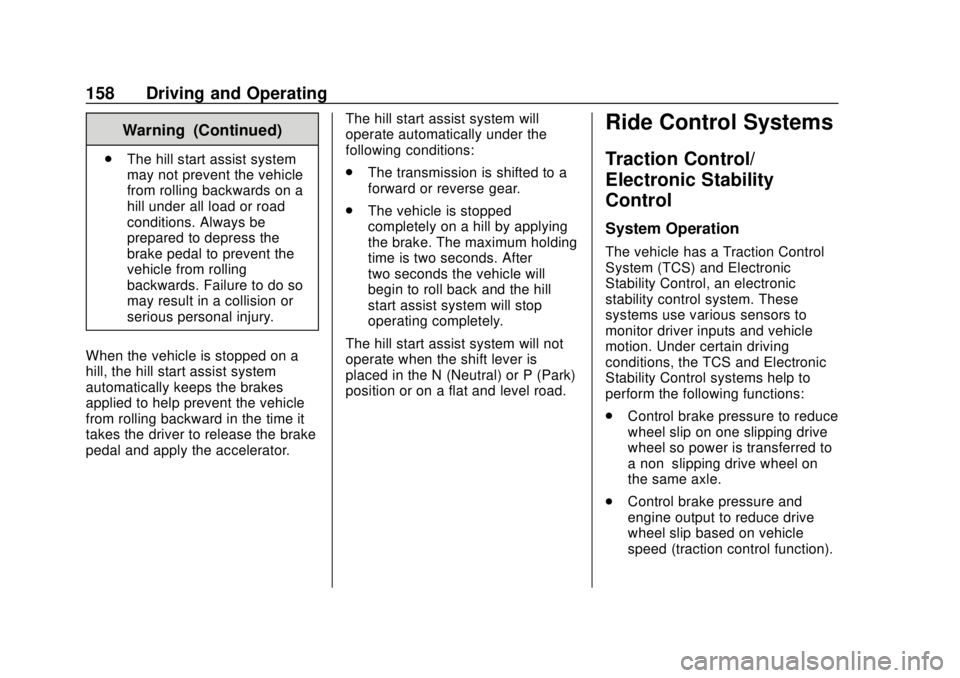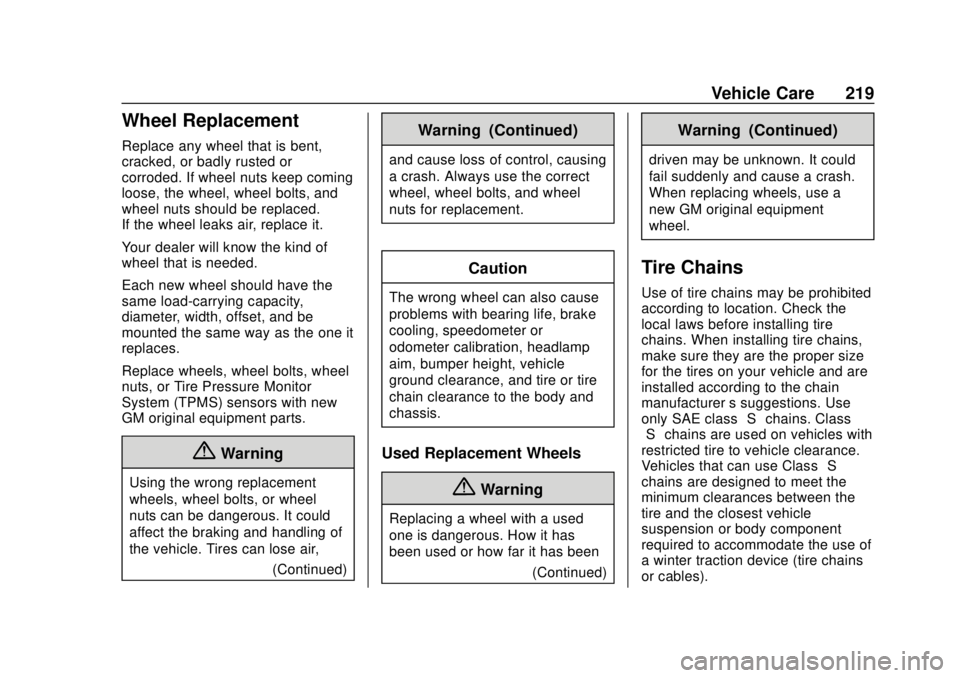brake sensor CHEVROLET CITY EXPRESS 2018 Owner's Manual
[x] Cancel search | Manufacturer: CHEVROLET, Model Year: 2018, Model line: CITY EXPRESS, Model: CHEVROLET CITY EXPRESS 2018Pages: 287, PDF Size: 4.19 MB
Page 105 of 287

Chevrolet City Express Owner Manual (GMNA-Localizing-U.S./Canada-
11683523) - 2018 - CRC - 7/10/17
104 Lighting
Flash-to-Pass
This feature is used to signal to the
vehicle ahead that you want
to pass.
If the headlamps are off or in the
low‐beam position, pull the turn
signal lever toward you to
momentarily switch to high beams.
Release the lever to turn the
high-beam headlamps off.
Daytime Running
Lamps (DRL)
DRL can make it easier for others to
see the front of your vehicle during
the day.
A light sensor on top of the
instrument panel makes the DRL
work, so be sure it is not covered.
The DRL system makes the
low-beam headlamps come on at a
reduced brightness when the
following conditions are met:
.The ignition is in the ON
position. .
The exterior lamp control is in
the OFF position.
. The parking brake is released.
If the parking brake is applied
before the engine is started, the
DRL do not come on.
When the DRL are on, only the
low-beam headlamps, at a reduced
level of brightness, will be on. The
taillamps, sidemarker, instrument
panel, and other lamps will not
be on.
Turn the exterior lamp control to
the;or5position for full
illumination when driving at night.
The DRL remain on until the ignition
switch is placed in the OFF position.
Hazard Warning Flashers
The hazard warning switch is on the
center stack below the climate
control system.
Press this button to make the front
and rear turn signal lamps flash on
and off. This warns others that you
are having trouble. Press again to
turn the flashers off.
The hazard warning flashers work
with the ignition switch in any
position.
Some localities may prohibit the use
of the hazard warning flashers while
driving.
Turn and Lane-Change
Signals
Move the lever all the way up or
down to signal a turn.
Page 159 of 287

Chevrolet City Express Owner Manual (GMNA-Localizing-U.S./Canada-
11683523) - 2018 - CRC - 7/10/17
158 Driving and Operating
Warning (Continued)
.The hill start assist system
may not prevent the vehicle
from rolling backwards on a
hill under all load or road
conditions. Always be
prepared to depress the
brake pedal to prevent the
vehicle from rolling
backwards. Failure to do so
may result in a collision or
serious personal injury.
When the vehicle is stopped on a
hill, the hill start assist system
automatically keeps the brakes
applied to help prevent the vehicle
from rolling backward in the time it
takes the driver to release the brake
pedal and apply the accelerator. The hill start assist system will
operate automatically under the
following conditions:
.
The transmission is shifted to a
forward or reverse gear.
. The vehicle is stopped
completely on a hill by applying
the brake. The maximum holding
time is two seconds. After
two seconds the vehicle will
begin to roll back and the hill
start assist system will stop
operating completely.
The hill start assist system will not
operate when the shift lever is
placed in the N (Neutral) or P (Park)
position or on a flat and level road.
Ride Control Systems
Traction Control/
Electronic Stability
Control
System Operation
The vehicle has a Traction Control
System (TCS) and Electronic
Stability Control, an electronic
stability control system. These
systems use various sensors to
monitor driver inputs and vehicle
motion. Under certain driving
conditions, the TCS and Electronic
Stability Control systems help to
perform the following functions:
. Control brake pressure to reduce
wheel slip on one slipping drive
wheel so power is transferred to
a non–slipping drive wheel on
the same axle.
. Control brake pressure and
engine output to reduce drive
wheel slip based on vehicle
speed (traction control function).
Page 220 of 287

Chevrolet City Express Owner Manual (GMNA-Localizing-U.S./Canada-
11683523) - 2018 - CRC - 7/10/17
Vehicle Care 219
Wheel Replacement
Replace any wheel that is bent,
cracked, or badly rusted or
corroded. If wheel nuts keep coming
loose, the wheel, wheel bolts, and
wheel nuts should be replaced.
If the wheel leaks air, replace it.
Your dealer will know the kind of
wheel that is needed.
Each new wheel should have the
same load-carrying capacity,
diameter, width, offset, and be
mounted the same way as the one it
replaces.
Replace wheels, wheel bolts, wheel
nuts, or Tire Pressure Monitor
System (TPMS) sensors with new
GM original equipment parts.
{Warning
Using the wrong replacement
wheels, wheel bolts, or wheel
nuts can be dangerous. It could
affect the braking and handling of
the vehicle. Tires can lose air,(Continued)
Warning (Continued)
and cause loss of control, causing
a crash. Always use the correct
wheel, wheel bolts, and wheel
nuts for replacement.
Caution
The wrong wheel can also cause
problems with bearing life, brake
cooling, speedometer or
odometer calibration, headlamp
aim, bumper height, vehicle
ground clearance, and tire or tire
chain clearance to the body and
chassis.
Used Replacement Wheels
{Warning
Replacing a wheel with a used
one is dangerous. How it has
been used or how far it has been
(Continued)
Warning (Continued)
driven may be unknown. It could
fail suddenly and cause a crash.
When replacing wheels, use a
new GM original equipment
wheel.
Tire Chains
Use of tire chains may be prohibited
according to location. Check the
local laws before installing tire
chains. When installing tire chains,
make sure they are the proper size
for the tires on your vehicle and are
installed according to the chain
manufacturer’s suggestions. Use
only SAE class “S”chains. Class
“S” chains are used on vehicles with
restricted tire to vehicle clearance.
Vehicles that can use Class “S”
chains are designed to meet the
minimum clearances between the
tire and the closest vehicle
suspension or body component
required to accommodate the use of
a winter traction device (tire chains
or cables).